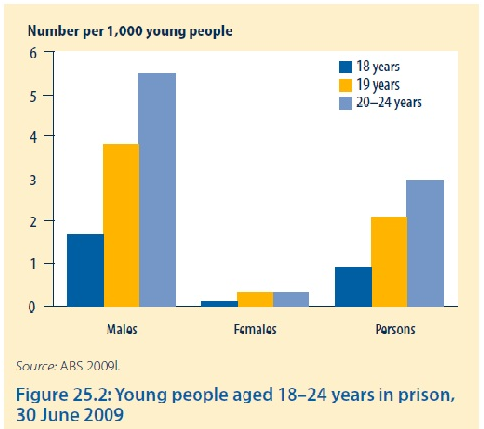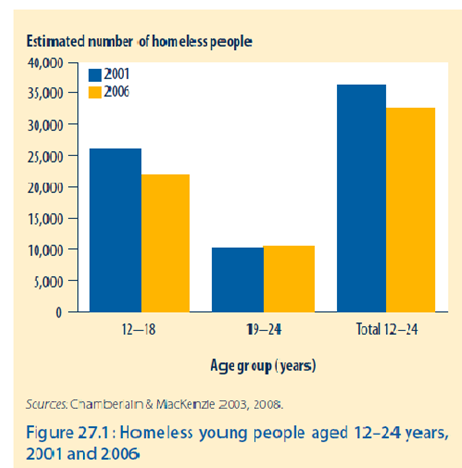Introduction
The health and well being of the youth are vital to a country’s future. The Australian government’s efforts to build an improved society are ambitious. Australian policy makers have set determined targets for a better future for its young populace with the help of policies and initiatives (AIHW, 2011). Numerous initiatives are in place to ensure the physical and emotional health and wellbeing of young Australians (AIHW, 2011).
However, several problems in the Australian society have become a serious cause for concern, specifically because these problems have a direct impact on the future of the young people and consequently the future of Australia. Of these, the important issue of the high rate of crimes among young Australians is particularly pressing.
If the Australian government aspires to achieve its ambitious goal of making Australia an ideal country with minimal problems, it will first have to seek the cause for criminal activities among young Australians. Two important causes for increased criminal activity among young Australians are homelessness and mental disorders.
Homelessness itself is seen rising in Australian children; the government is well aware that in order to meet its goals for a better society for the youth by 2020, it will need to address the root cause of these issues (Victoria Government Department of Human Services, 2010).
Without identifying the causes and effects of homelessness and mental health on Australian youth it will be difficult to effectively address the issue of crime among young Australians. This report identifies the causes of criminal activity among the young people of Australia, a major hurdle in achieving a better society for youth by the year 2020.
This research seeks to explicate the two most important causes of crime among young Australians; identifying and addressing these issues will help in achieving the targets for a better Australian youth society by the year 2020.
Literature Review
Youth offense is a cause for serious concern, not only because of the harm it causes to society but also because the offenders facing juvenile detention and imprisonment could be associated with more serious crimes later in life (Makkai & Payne 2003). Youth and adolescence is a period of rapid growth and bodily change. Puberty is the period when several hormonal changes take place which impacts adolescent behavior and attitude.
The escalating rates of drug abuse and crime among the young people of Australia, are an indicator of the serious social and psychological problems they face (Eckersley 2008). The image below shows the estimate of young people in prison between the ages of 18 years to 24 years (2009).
Some of the factors impacting criminal activity in young people are low socioeconomic status, low educational achievement, physical and mental health problems and a past history of child abuse and neglect (Kenny et al. 2006; NSW Department of Juvenile Justice 2003; Stewart et al. 2002).

Homelessness, child abuse/neglect and youth crimes
Recent data and studies clearly point to a link between homelessness, child abuse and criminal activity (AIHW, 2011). Statistics indicate that annually, about 100,000 children and young Australians seek homelessness services of which, 70,000 are wanted by the police for some form of criminal activity. About 14,500 are placed in juvenile detention centers (AIHW 2011).
The Australian government is committed to reducing the rate of homeless by 50% by the year 2020 (Jean, 2012). The concern for the large number of homeless youth in Australia has become widespread. In a news article, Peter Jean (2012) points to the connection between homelessness and crime.
He refers to a report by the AIHW which investigated the association between child protection, homelessness and juvenile justice.
He mentioned the results of the report stating that 15% of the juvenile youth had been homeless a year prior to their criminal activity. Jean (2012) stated that about 30% of the homeless population are young people below the age of 18 years. The number of homeless young Australians is indeed alarming and have a history of broken families, neglect and abuse.
In compliance with the above report, several studies indicate the strong relationship between child abuse and criminal activity (Stewart et al. 2005). The National Youth Commission (2008) affirms that homeless children are more likely to be found in child protection systems.
Further studies also affirm that many of the young juvenile offenders did not have a family or home support system (Kenny & Lennings 2007).
Weatherburn & Lind (2006) found that children with a history of neglect and abuse have lived with parents who rank low on the socioeconomic scale and were unable to adequately supervise their children, resulting in delinquent behaviors among children. The likelihood of homeless children being involved in child protection systems was found to be greater.
Such children had very little scope of education and were associated with survival crimes such as thefts (Cashmore, 2011).
The NSW Department of Juvenile Justice (2003) confirms that mental and physical health problems and substance abuse were found to be higher in children and adolescents who had been placed under juvenile supervision. Kenny and Lennings (2007) also found that these children have extremely low levels of educational attainment.
Mental health – Prevalence, statistics and causes
50% of the young population of Australia has found to be affected by a mental health disorder (Begg et al., 2007). About 24% of the young Australian are affected by anxiety and depression (Begg et al., 2007). Researchers have investigated the factors affecting the mental health of young Australians between the ages of 16 and 24 years.
The primary reasons for poor mental health in young adults were developmental and physical factors such as brain damage prior to birth, low level of intelligence, disability of the mind or body, lack of social skills and lack of self esteem (DHAC 2000). Mental health studies also found the impact of family violence, homelessness and poverty on the mental health of young people (Correa-Velez et al. 2010).
More specifically, lack of harmony within the family, child abuse, neglect and parental substance abuse were found to have a major negative impact on the mental health of children and adolescents (Patel et al. 2007). These studies certainly link the occurrence of mental health disorders among youth to homelessness, abuse and neglect.
Mental health and Crime
A report conducted by the Australian Institute of Health and Welfare (AIHW, 2010) found that young prisoners have severe mental health issues and substance abuse problems. In this report of the National Prisoner Health Census, the first of its kind to be conducted, young prisoners between the age of 18 years to 24 years were reviewed.
It was found that some inmates were severely affected by mental health issues when they entered the prison. About 33% of the young prisoners had been informed by a mental health practitioner about their mental health problem.
27% of the young prisoners were using mental health services prior to coming to prison and within the prison. 16% of the young prisoners had been prescribed medication for their mental health illness. This report establishes the link between mental health illness and criminal activity among the young Australian offenders.
Discussion
There is a clear association between “abuse and neglect, homelessness and juvenile crime” (Jean, 2012). Homelessness is a serious problem in Australia causing a number of issues – social, physical, psychosocial and mental. The percentage of the young homeless in Australia is very high and still increasing. This rise in homelessness is in a way directly proportional to the rise in rates of crimes across Australia.
In a study conducted by Chamberlain and MacKenzie (2008) it was estimated that the total number of homeless youth in 2006 were 32,400, all of them between the ages 12 years to 24 years. Totally, they accounted for 31% of the total homeless population of Australia. The image below shows the estimated number of young homeless people in Australia in 2001 and 2006.

The youth of a nation are representative of its growth and development and play a vital role in its progress. With concrete data on the association between social factors such as homelessness and juvenile criminal activity, policy makers should focus on strategies to address these issues in order to effectively implement strategies for a better future for the Australian youth by 2020.
Conclusion
Eradication of serious problems like youth crimes necessitate serious intervention strategies. Achieving the targets for 2020 is an ambitious initiative of the Australian government.
Identification of the factors such as homelessness and mental health disorders on criminal activity of young people will help in creating policy initiatives to address these issues. With appropriate measures, the government will be successful in creating a better society of focused and centered Australian youth by the year 2020.
Reference List
Australian Institute of Health and Welfare (AIHW) 2011, Young Australians: Their Health and Wellbeing 2011, Cat. No. PHE 140, AIHW, Canberaa.
Australian Institute of Health and Welfare (AIHW) 2010, The health of Australia’s prisoners, 2009. Cat. no. PHE 123. AIHW, Canberra.
AIHW 2011, Juvenile justice in Australia 2008–09, Cat. no. JUV6, AIHW, Canberra.
Begg, S, Vos, T, Barker, B, Stevenson, C, Stanley, L, & Lopez, A. 2007, The burden of disease and injury in Australia, 2003, AIHW, Canberra.
Cashmore J 2011, ‘The link between child maltreatment and adolescent offending: systems neglect of adolescents’, Family Matters, vol.89, pp. 31–41.
Chamberlain C & MacKenzie D 2008, Australian Census analytic program: counting the homeless, 2006, ABS cat. no. 2050.0, Australian Bureau of Statistics, Canberra.
Correa-Velez, I, Gifford, S, & Barnett, A. 2010, ‘Longing to belong: social inclusion and wellbeing among youth with refugee backgrounds in the first three years in Melbourne’, Social Science and Medicine, vol. 71, no. 8, pp. 1399–1408.
DHAC (Australian Government Department of Health and Aged Care) 2000, Promotion, prevention and early intervention for mental health—a monograph, DHAC, Canberra.
Eckersley, R 2008, Never better – or getting worse? The health and wellbeing of young Australians, Australia 21 Ltd, Canberra.
Jean, P 2012, Homelessness and crime link: study, <https://www.canberratimes.com.au/story/6163481/homelessness-and-crime-link-study/>
Kenny, D, T, Nelson, P, Butler, T, Lennings, C, Allerton, M, & Champion, U, 2006. NSW young people on community orders health survey 2003–2006: key findings report, University of Sydney, Sydney.
Kenny, D & Lennings, C, J 2007. The relationship between head injury and violent offending in juvenile detainees, NSW Bureau of Crime Statistics and Research,. Sydney.
Makkai, T & Payne, J 2003, Drugs and crime: a study of incarcerated male offenders, Research and public policy series no. 52, Australian Institute of Criminology, Canberra.
Marshall, J 2006, Juvenile offending trajectories: a South Australian study, Office of Crime Statistics and ResearchNIMH, 2001, Adelaide.
National Youth Commission 2008, Australia’s homeless youth: a report of the National Youth Commission Inquiry into Youth Homelessness, National Youth Commission, Brunswick Victoria.
NSW Department of Juvenile Justice 2003, NSW Young People in Custody Health Survey: key findings report, NSW Department of Juvenile Justice, Sydney.
Patel, V, Flisher A, J, Hetrick, S & McGorry P ,2007, ‘Mental health of young people: a global publichealth challenge’, The Lancet, vol. 369, no. 9569, pp. 1302–1313.
Stewart, A, Dennison, S & Waterson, E 2002, Pathways from child maltreatment to juvenile offending, Trends and issues in crime and criminal justice no. 241, Australian Institute of Criminology, Canberra.
Stewart, A, Dennison, S & Hurren, E 2005. Juvenile offending trajectories: pathways from child maltreatment to juvenile offending, and police cautioning in Queensland, School of Criminology and Criminal Justice, Griffith University, Brisbane.
Victoria Government Department of Human Services. (2010). A Better Place Victorian Homelessness 2020 Strategy. Victoria. Melbourne.
Weatherburn, D & Lind, B 2006, ‘What mediates the macro-level effects of economic and social stress on crime?’, The Australian and New Zealand Journal of Criminology, vol. 39, no. 3, pp. 384–397.